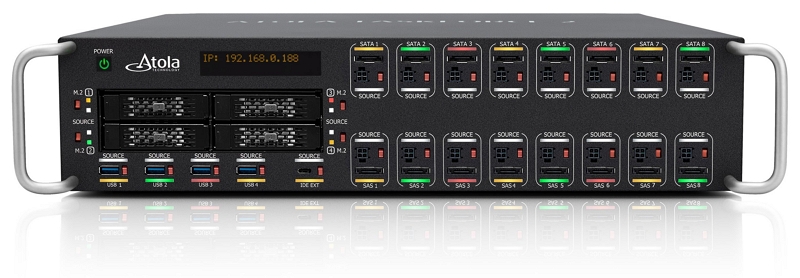Atola Technology releases TaskForce 2, a new version of its flagship forensic imager. The new device has 26 ports, including four M.2 NVMe ports, and can image 25+ drives simultaneously, including damaged media, reaching 25 TB/hour cumulative speed.
With TaskForce 2, forensic examiners can automatically reassemble and image RAIDs with an unknown configuration, benefit from workflow automation tools, thanks to the built-in Web API, and collaborate with colleagues using a single high-performance hardware unit.
“With TaskForce 2, its 26 ports, powerful server-grade hardware and damaged drive support we’re taking forensic imaging to a whole new level,” said CTO Vitaliy Mokosiy. “We invested a great deal of time and effort in engineering, development and testing to help forensic specialists across the globe reduce their backlogs of ever-growing amounts of evidence data.”
26 ports, including M.2/U.2 NVMe, SATA, SAS, and USB
To simultaneously image more than 25 evidence devices and run other forensic tasks at 25 TB per hour, TaskForce 2 has ports of all popular types on its front panel. They include eight SATA, eight SAS/SATA, four NVMe (M.2 or U.2), four USB, and one IDE port. The additional Extension port is situated on the back side and designed for connecting M.2 SSD, Apple PCIe SSD, and Apple Thunderbolt extension modules.
All 26 ports can be configured according to examiners’ needs: each port can be set either to the source or target mode. The source mode turns on the hardware write protection to eliminate any possibility of altering digital evidence. A dedicated LED indicator next to each port signals that the source mode on this particular port is enabled. The target mode allows using a drive as an imaging target, altering or securely erasing its contents.
Additional color-coded port LEDs on the front panel indicate that a task is running or finished, a process is OK or there are issues.
TaskForce’s Express mode simplifies repeated tasks by automatically launching an imaging session with predefined settings once a drive is connected to TaskForce 2. This allows getting dozens of drives imaged into the same destination with zero clicks. Express mode can also be used for speeding up wiping or hash calculation.
Atola Device Rack
To neatly organize evidence drives while imaging them, exclusively for TaskForce 2, the dev team designed Atola Device Rack. One Device Rack stores up to eight drives and can either be placed on top of or below TaskForce 2 hardware unit or mounted on a server rack.
Each of the eight numbered bays can contain one 3.5-inch or 2.5-inch drive and is high enough for the tallest SAS drives. Bay numbering suggests the most convenient scheme to place drives connected to the respective SATA or SAS ports of TaskForce 2.
To cool down the drives during resource-consuming operations, Device Rack is equipped with two fans situated on its back panel.
Server Rack Compatibility
TaskForce 2 is designed primarily for in-lab usage and can be mounted into a standard server rack, along with one or two Atola Device Racks. The size of the rackmount for both TaskForce 2 and Atola Device Rack is 3U.
Workflow Automation Tools
The built-in Web API enables the integration of TaskForce 2 into an automated evidence processing sequence, created using Magnet AUTOMATE and other commercially available or in-house workflow automation tools.
To enable the integration, API provides the ability to launch, track and stop physical or logical imaging operations via Web API.
Automated RAID Reassembly
TaskForce 2 functionality makes it possible to automatically identify unknown configurations of RAID arrays and reassemble RAID 0, 1, 5, 10, or JBOD. For RAID 5, TaskForce 2 software can rebuild an array even with a missing or damaged device, using parity blocks.
The RAID module works even with damaged media and supports both physical drives and their images.
After RAID configuration is automatically detected and applied, a forensic examiner can preview the RAID contents and image the whole array or only selected partitions, folders, and files.
Multi-User Access
Thanks to a web-based user interface and built-in user management system, forensic specialists can use a single hardware unit to perform acquisition tasks simultaneously. Each user’s processes, reports, and cases are kept separate and confidential.
The control interface is user-friendly and accessible in the Chrome browser on any device within the same local network: a computer, tablet, or phone.
About Atola Technology
Atola Technology is an innovative company based in the Vancouver area, Canada, specializing in creating forensic imaging hardware tools for the global forensic market.
Atola’s engineers – including its founder and CEO Dmitry Postrigan – have strong expertise in storage media and data recovery, and focus on creating highly efficient and user-friendly forensic imagers.

















